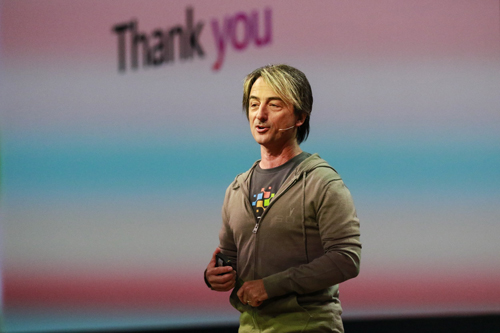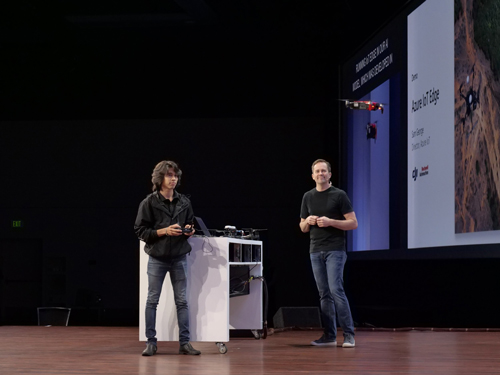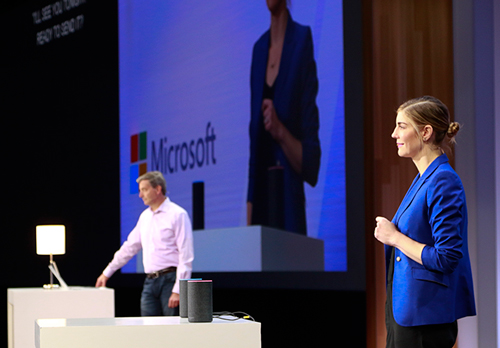Top 11 Key Moments from Microsoft Build
Microsoft Build 2018, the company's flagship developer conference, wrapped up this week in Seattle with a lot of news. With dozens of announcements, including 70 new capabilities in Azure and more than 100 new features for the Bot Framework, it's impossible to capture even all of the important ones. What follows are 11 key moments from the three main keynotes that highlight important themes of the show.
1. Microsoft 365 Gets Promoted
It's been clear for a long time that Microsoft Azure is the key strategic umbrella platform for Microsoft. The question is, how does Microsoft prioritize and organize the rest of its products? At least for Build, Microsoft CEO Satya Nadella made that clear.
"We're focused on two massive platform opportunities. One, Microsoft Azure, the other Microsoft 365," Nadella said in his kickoff keynote.
The designation of Microsoft 365 up alongside Azure is a significant elevation or promotion for Microsoft 365, which previously seemed more like a licensing construct rather than an organizing principle for Windows 10, Office 365 and Enterprise Mobility and Security (EMS) services.
Joe Belfiore, corporate vice president for Windows at Microsoft, expanded on the architectural vision around Microsoft 365 in his Day 2 keynote. "We want Microsoft 365 to embrace multiple devices. We want it to be smart about letting users move from a PC to a phone. We want Microsoft 365 to embrace multi-sense use. We want it to be able to fluidly go from mouse and keyboard to touch to ink. We want to be embracing vision, new ways of working like wearing a VR display, and so a lot of these ideas are not only work that we're doing in the products that we build, but we're also trying to platformize so the code that all of you build will make your organizations more effective in the same kind of way," Belfiore said.
Short version, pay attention to Microsoft 365 as a platform.
 Joe Belfiore detailed Microsoft's vision for Microsoft 365 during his Day 2 Build keynote. (Source: Microsoft)
Joe Belfiore detailed Microsoft's vision for Microsoft 365 during his Day 2 Build keynote. (Source: Microsoft)
2. Azure is Accelerating
Microsoft's big ambitions for Azure itself are expanding. Nadella laid out Microsoft's grandiose plans rather bluntly.
"Azure is being built as the world's computer," Nadella said.
He marshalled a fair amount of evidence for the assertions around Azure's scale:
- There are more than 50 regions
- The Azure cloud counts 70-plus certifications worldwide
- About 70 new Azure capabilities were launched during Build
Nadella also enumerated all the ways the platform is expanding beyond the core public cloud service: "As computing spreads, as there is need for computing at the edge, we are building out Azure, Azure Stack, Azure IoT Edge and Azure Sphere as this one computing fabric that supports this new application model."
That intelligent edge emerged as an important theme at Build, and Microsoft also spent some time clarifying use cases for Azure Stack, the private cloud version of Azure that a company can run in its own datacenter disconnected from the public cloud. Azure Stack is not just, or even primarily, about organizations that distrust public cloud networks. Instead, Microsoft is positioning Azure Stack as a prime example of the intelligent edge.
"Azure Stack, which is just a year old, is supporting multiple scenarios. For example, Chevron is using it so that they can essentially have Azure in a disconnected way at their oil rigs. A bank in South Africa, ABSA, is using it for their regulatory workloads, as well as using the public cloud, Azure. And then Schlumberger is actually doing distributed computing. So they use the public cloud, as well as Azure Stack, as one fabric to be able to distribute compute so that it's close to where the data is," Nadella said.
3. Commoditizing AI
Closely linked to Azure is artificial intelligence, and AI was a huge theme at Build.
Nadella reeled off a number of milestones Microsoft had achieved comparing machine performance versus human performance on various tasks, but then put them in a perspective that demonstrated Microsoft's AI philosophy.
"Who cares about breakthroughs we achieve? What matters is can we translate these into frameworks, tools and services, and put them in your hands as developers so that you can take AI and have impact in every industry in every application. That's what's important. We truly are committed to, in some sense, commoditizing AI," Nadella said.
Among the more specific AI announcements during Build week, one significant enhancement was a preview of Project Brainwave, a distributed, real-time AI fabric that currently works with FPGAs from Intel.
4. 200 Million Corporate Users of Windows 10
Belfiore shared Windows 10 deployment momentum numbers that show Microsoft's flagship client OS gaining traction among business users.
"We see Windows 10 deployment really ramping up significantly in commercial accounts. Right now there are over 200 million people in corporate accounts using Windows 10 and we've seen that adoption rate increase now at 79 percent year-over-year growth," Belfiore said.
5. Bring Out the Drones
A big theme at Build was enabling developers to create solutions combining Internet of Things (IoT), Azure cloud, AI, cameras and drones.
Sam George, director of Azure IoT Engineering and Program Management at Microsoft, oversaw a keynote demo of a drone visually inspecting pipes for damage.
"For the first time ever, we're able to stream video back from that drone to this laptop running IoT Edge and our AI model, which was developed in the cloud," George said.
Major related news at the show included camera partnerships with Qualcomm, a drone-related partnership with DJI and the revival of Kinect, Microsoft's groundbreaking motion sensor for gaming, as an IoT device.
 [Click on image for larger view.] Executives from Microsoft and DJI gave a demo of new technology being used in drones. (Source: Microsoft)
[Click on image for larger view.] Executives from Microsoft and DJI gave a demo of new technology being used in drones. (Source: Microsoft)
6. New Tricks for Cortana
The Microsoft digital assistant Cortana was a star of the show, most visibly in an on-stage demo with Amazon Alexa. The two assistants called upon one another to handle tasks in their specialty areas, with Alexa focusing on home and consumer jobs and Cortana handling work schedules and e-mails.
Tom Taylor, a senior vice president for Amazon Alexa, had one of the best applause lines of the show when he asked Alexa: "What do you think about Cortana?" Alexa replied: "I like Cortana. We both have experience with light rings, although hers is more of a halo."
A significant theme around Cortana was the emergence of the personification of AI as Cortana-based assistance versus being an assistant.
In that vein and around the broader enablement of chats and bots, Nadella said, "At this conference, we're launching 100-plus new features for the Bot Framework so that you can continue to build these conversational interfaces and give them more of the customization. So, for example, you can have a custom wake word, you can give it custom speech, you can even give it custom personality, take some of the FAQs and turn them into Q&A. And then take the corpus of data you have in terms of conversations and use that as label data to have a full dialogue system."
 Megan Saunders of Microsoft and Tom Taylor of Amazon demo the limited beta version of Cortana-Alexa integration. (Source: Microsoft)
Megan Saunders of Microsoft and Tom Taylor of Amazon demo the limited beta version of Cortana-Alexa integration. (Source: Microsoft)
7. Open Source Love Continues
Microsoft can't get developers together anymore without professing its undying commitment to open source in some way.
This time it took the form of a testimonial from Jason Warner, the senior vice president of technology at GitHub, who took the keynote stage to talk about the scale of Microsoft's efforts on GitHub.
"I think it's amazing to see what Microsoft has done in the past few years," Warner said. "The industry has shifted, and they realize the power of open source. And, in fact, I don't think it's too bold to say that open source now powers modern software development. And Microsoft might be the best example of a corporation embracing open source. We know from statistics that we have in GitHub that Microsoft is the single largest corporate contributor to open source on GitHub, and there by extension, in the history of open source. In fact, Microsoft has the largest open source community in the entire world with Visual Studio Code."
8. Expanding the Container Story
Microsoft used Build to disclose a further push into the world of containers, with the announcement of the Azure Kubernetes Service (AKS).
"Our new AKS or Azure Kubernetes Service, provides a fully managed Kubernetes-based orchestration service. It provides built-in auto-patching, auto-scaling and update support, which enables you to take the full-breadth of the Kubernetes ecosystem when you're doing your development," Guthrie said.
9. Faster and Potentially Cheaper Cosmos DB
Microsoft's Cosmos DB has been growing by leaps and bounds. During Microsoft's last financial earnings call, Nadella told investors that the product was on a $100 million annualized revenue pace, making it the fastest-growing database product he'd seen out of the company.
Cosmos DB is a globally distributed database that is a core service of all Azure datacenters, allowing customers to scale geographically, and has support for multiple models, including document, graph, key-value, table and column-family, with APIs for SQL, MongoDB, Cassandra, Gremlin and Table.
At Build, Microsoft unveiled several improvements to Cosmos DB, including a new pricing option that Guthrie said could lead to major cost savings, and, on the technical side, a feature called multi-master write support.
"Cosmos DB now supports unlimited read and write scalability by virtue of a highly decentralized master-less replication protocol support," Guthrie said. "This guarantees single-digit millisecond reads and now writes response time at the 99th percentile anywhere in the world, which is something no other database in the world delivers today."
10. Get To Know the Graph
Alongside the rise of Microsoft 365 comes the rise of an underlying technology called the Microsoft Graph.
Belfiore called the Graph one of the most important things that Build attendees should understand for his Microsoft 365-focused Day 2 keynote.
"I just want you to come into the keynote with one key idea, which is that the Graph is a cloud-backed data store where both you and us can put organizational data in a way that's private and secure to the organization, but in a way that also lets our solutions take advantage of both so that AI can reason against that data, that organizational data, and so that the experiences that both we build and you build can light up and make those end users' lives better," Belfiore said.
Many of the announcements and demos during the keynote related to the Graph. Notable ones included Timeline, a technology that lets users scroll back through their history of activities with the ability to click on entries to pick up where they left off. A related concept was Sets, which could also be accessed through the Timeline, but which allow users to bring up the entire context of a project, such as a Word document with the associated browser tabs that were being used in researching the document.
11. Laying Down a Responsibility Marker
In an era when Facebook executives are testifying before Congress and cable news shows feature constant discussion about technology's role in democratic elections, Nadella laid down a marker on responsibility.
"We...have a responsibility as a tech industry to build trust in technology," Nadella said right at the start of his Build keynote. Echoing recent comments from Microsoft President Brad Smith, Nadella said Microsoft is focused on three core pillars: privacy, cybersecurity and ethical AI.
Posted by Scott Bekker on 05/11/2018